During the summer after her first year at Bates, Paige Magid ’24 of Washington, D.C., was on vacation in New Orleans with her dad when they passed a restaurant just as an employee ran outside yelling for help.
The hostess was having a seizure and the staff didn’t know what to do. Creighton Magid simply pointed at his daughter and said: “She’s an EMT.”
“They had me come into the restaurant, and I saw this lady on the floor with her eyes open and her lips turning blue,” Paige Magid recalls. “I went over and took her pulse. Her jaw was clenched and people tried to open it and I told them, ‘No, no, no. You’re going to injure her. You need to go about this in a different way.’”
Magid’s quick action helped to keep the woman in stable condition until paramedics arrived. She relied on training she’d just received at Bates during her first Short Term, after which she became nationally certified as an emergency medical technician.
Last spring, after graduating with a double major in biology and theater, and with three years of practical experience with Bates Emergency Medical Services, Magid headed to Yale to pursue a master’s degree in public health in chronic disease epidemiology.
Such is the impact of Bates EMS, the college’s all-volunteer, student-run, state-certified emergency medical service, which was founded by four Bates students in 1995. Since then, the service has become an integral part of supporting the well-being of Bates people while simultaneously training and inspiring students, hundreds of them over the decades, to provide life-saving medical care.
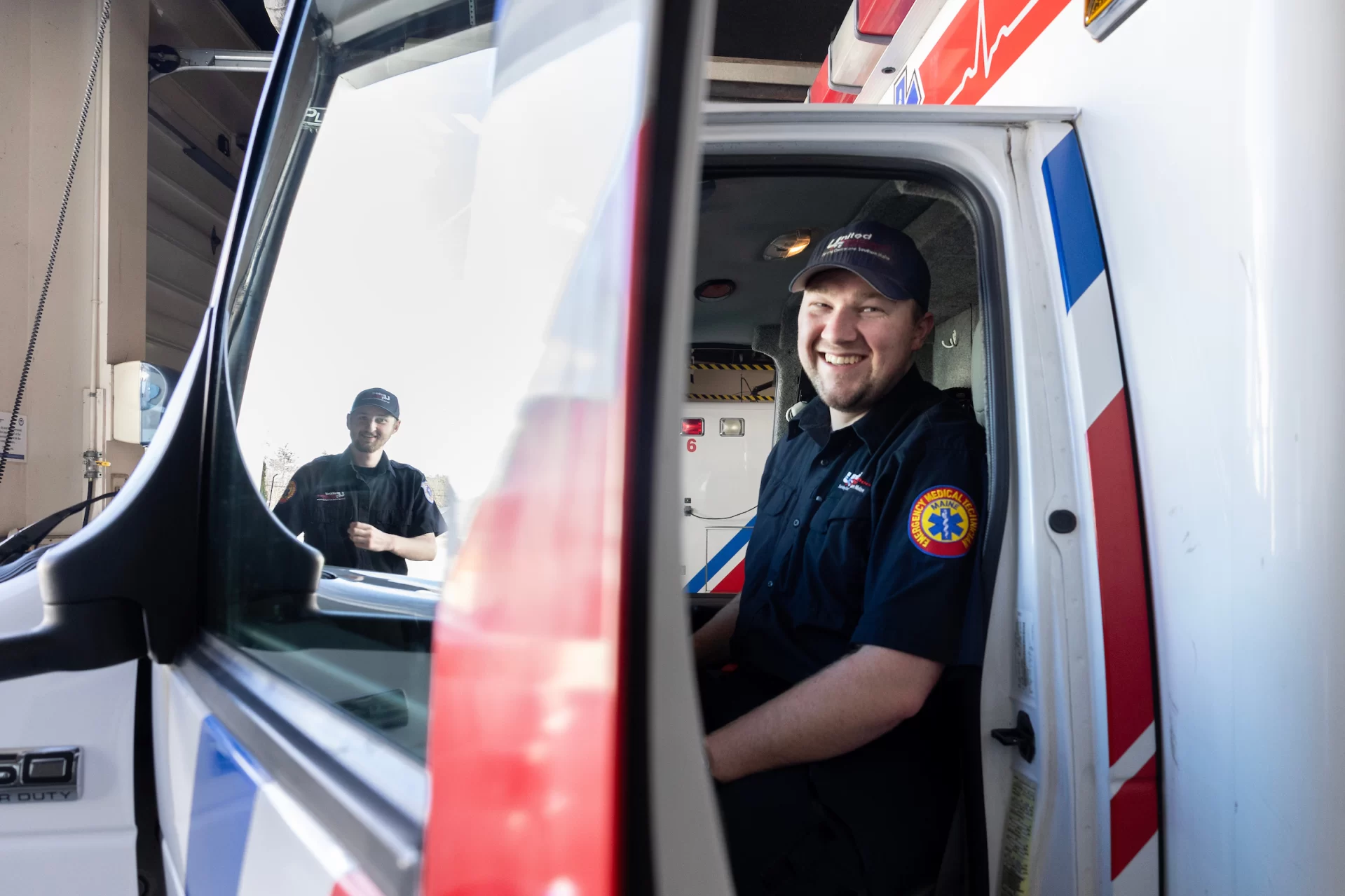
At its core, say BEMS alumni, the service is about fostering a life philosophy grounded in caring for one’s community. In addition to medical know-how, BEMS teaches such powerful life skills as listening carefully to others, responding with empathy, slowing down to take note of your surroundings, and, fundamentally, how to harness the kind of rock-solid courage needed in emergencies, and not just medical ones.
“One of the best things it taught me was how to listen to people, through looking and listening to your patient. We do not do that very well as humans,” says Madeline Bruno ’17, who is now a geologist but kept and used her EMT certification when she served on a volunteer ambulance crew just after college.
Today, there are more than 250 college and university EMS services across the country, and most are student-run, according to the National Collegiate EMS Foundation. But not all are state-licensed like BEMS, which means it adheres to the regulatory procedures and policies of state-certified ambulance crews, a distinction that makes it unique in Maine.
At any given time, BEMS numbers around 30 members, many of whom also work part time on local ambulance crews such as United Ambulance in Lewiston, near the Bates campus on Russell Street, and others in surrounding towns like Lisbon, Turner, Monmouth, and Durham — adding another layer of learning as they form connections in local communities.
“The way you get to know your community is really, really unique,” says David Kingdon ’98 of Wailuku, Hawaii, one of the four founders of BEMS 29 years ago. Now a paramedic on the island of Maui, he served as a first responder coordinating medical care during the wildfires of August 2023.
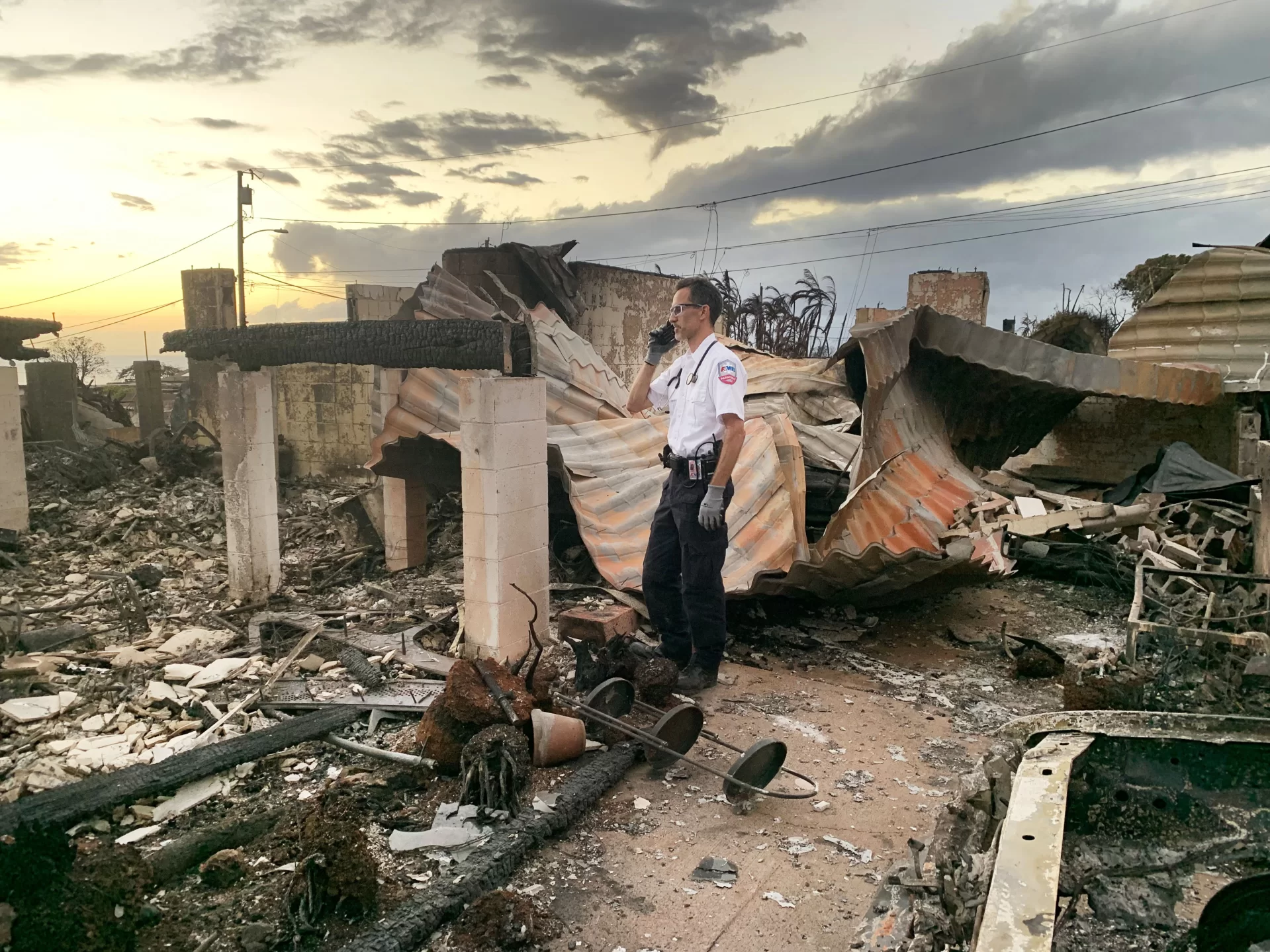
“It builds confidence in handling stress and crisis. It’s also about just having one’s worldview opened up a bit, even for those who don’t go into a related field. It’s a great way to know your town at a deeper level.”
It’s also a way to know your college on a deeper level, says Magid. “BEMS has shaped a lot of the way that I see Bates. It was a lot of fun, but it also was sort of a leadership role. I’ve had to be in some really serious situations. I’ve shown up at a call early in the morning where someone was unresponsive. It turned out to be fine. But that was definitely scary.”
Magid didn’t come to Bates planning to study medicine, and she took Bates’ Short Term EMT course on a whim. But after responding to about 30 EMS calls on the Bates campus, she’s been imbued with a can-do sense of civic duty that has helped her discover a purposeful career path.
Nearly 30 years after it was founded, BEMS continues to evolve and offer students more. Most recently, there has been a significant shift in making BEMS more accessible to students, regardless of their ability to pay for training.
Three years ago, a donor came forward to fund the Short Term EMT class to make it free for all 16 students taking the intensive, 40-hour, three-week course, which previously cost $1,500 to $3,000 per participant. Bates hopes to continue to underwrite the cost of the course.
In addition, students now receive academic credit for taking the EMT course, like all other Short Term courses, removing another barrier to access.
Bates donors have noted how BEMS impacts the community in other ways. After three members of Bates EMS, in their part-time work with United Ambulance, were among the first medical responders to the mass shootings in Lewiston on Oct. 25, 2023, a Bates alumni family established a $100,000 endowment to support BEMS operations, including the cost of training.
And in April, donors again came to the rescue, as a Bates family offset the $62,000 cost of a new Bates vehicle. The 2022 Ford SUV, similar to a Ford Explorer, replaces an aging 2007 Toyota Highlander, affectionately known as “Heidi the Highlander,” used by generations of Bates students.
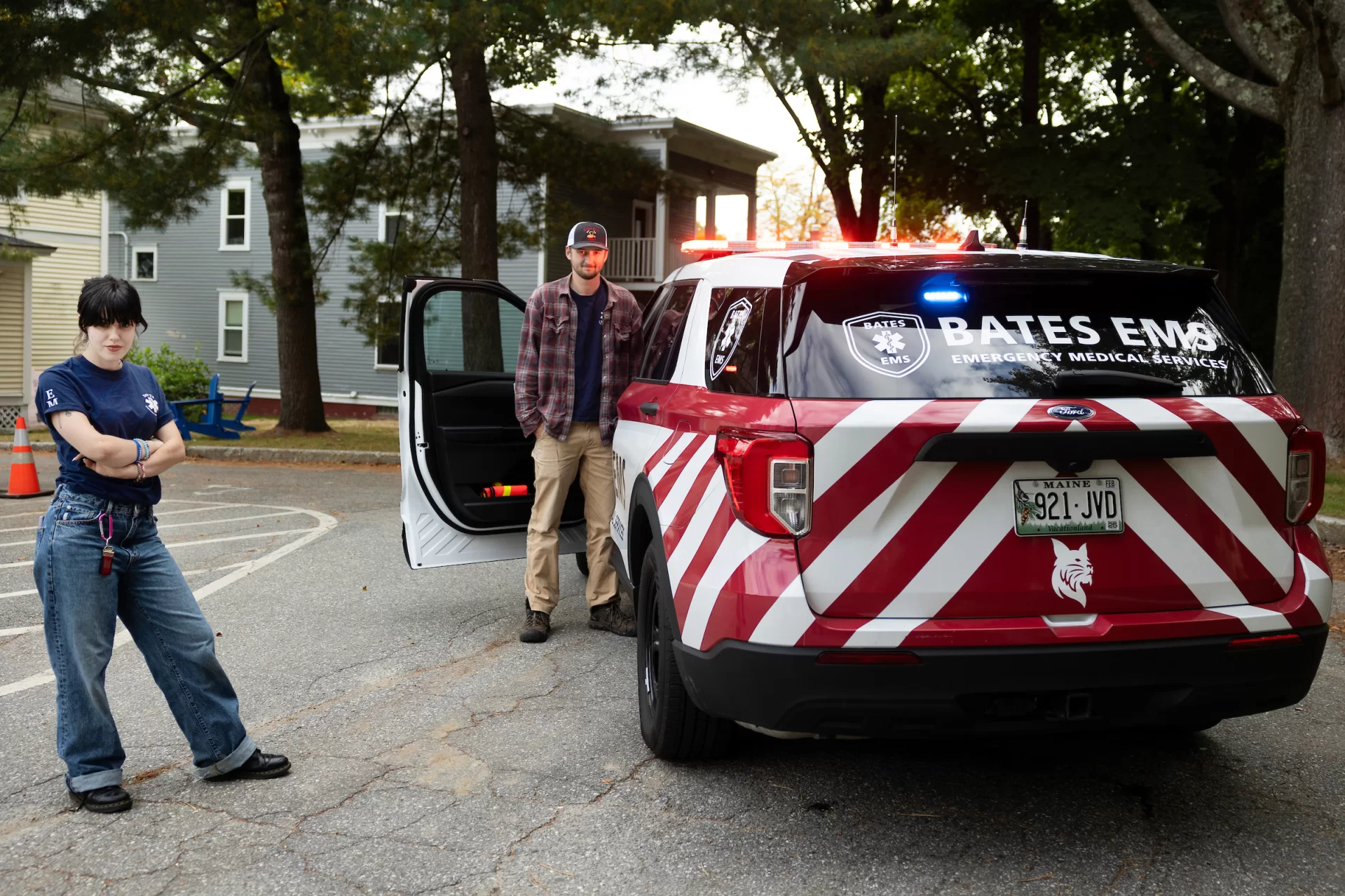
“This family has an appreciation for what these students do for our community, and in their communities as Bates alumni,” says Geoff Swift, vice president for finance and administration and treasurer, who oversaw the purchase. “And we were thrilled that they were interested in supporting this vehicle for the students.”
While the BEMS vehicle doesn’t transport patients to the hospital, it does need to arrive quickly on the scene, carrying all the gear typically needed to aid victims of medical emergencies, from backboards and medications to equipment that provides breathing assistance.
“This car has increased space to carry gear, and we plan to design the trunk in a way that will make it easier to access our gear on a call,” says Ned Friedman ’24 of Park City, Utah, who served as BEMS co-chief this past academic year. “That will reduce wait times.”
BEMS was started in the 1995–96 academic year by four students who all earned their EMT certification in high school and wished to continue as EMTs in college. Its beginnings were modest. “We didn’t even have a basic vehicle the whole three years that I was there. Most of us were on foot or on bicycle,” says Kingdon.
Since then, all four founders have remained devoted to a life in medical and community service.
Kingdon, who spearheaded the founding effort, is currently a special operations and flight paramedic with Maui County EMS and is also a professor of emergency medical services with the University of Hawaii. He has hosted several Purposeful Work interns in the past, including Friedman this spring.
Another BEMS co-founder, Michael Schlechter ’99, went into business after Bates and now volunteers his time as chief of his Connecticut hometown’s EMS, which earned state “Volunteer Agency of the Year” honors in 2023.
Peter Tilney ’99 earned a medical degree from the University of New England and is now an emergency-room physician in Lewiston as well as the medical director of LifeFlight of Maine, the state’s air-ambulance service.

And Pete Linkroum ’99 of Baltimore is an acute nurse practitioner in the Department of Palliative Medicine at MedStar Franklin Square Hospital in Baltimore.
BEMS could have remained a private service, similar to what many other colleges and universities offer. But the four founders wanted it recognized by the state of Maine, even though as a non-transporting service it would primarily serve the Bates campus community.
“Here we are over 25 years later, and it’s still an active service and a vibrant organization,” Kingdon says. “These may be young people, but they’re very mature and very responsible, and totally capable of serving and, frankly, running a small EMS service. I think it’s important that everyone acknowledge that.”
Since its inception, BEMS has been run by student co-chiefs with programmatic support from Student Affairs. This spring, co-chiefs Friedman and Noah Bachner ’25 of Weston, Conn., met weekly professional staff in the college’s Office of Residence Life and Health Education to develop leadership and training opportunities.
In addition, the co-chiefs also now check in with Dennis Russell, United’s education manager and paramedic program director, who came on as a Bates advisor in 2016 to help monitor the service’s compliance with constantly changing state protocols.
Each year, about 30 BEMS volunteers commit to a minimum of five 24-hour shifts a month, including one weekend shift. During those days on duty, they remain on campus and carry radios and medical gear with them while going about their normal routines of attending class, dining in Commons, and sleeping in their residence hall.
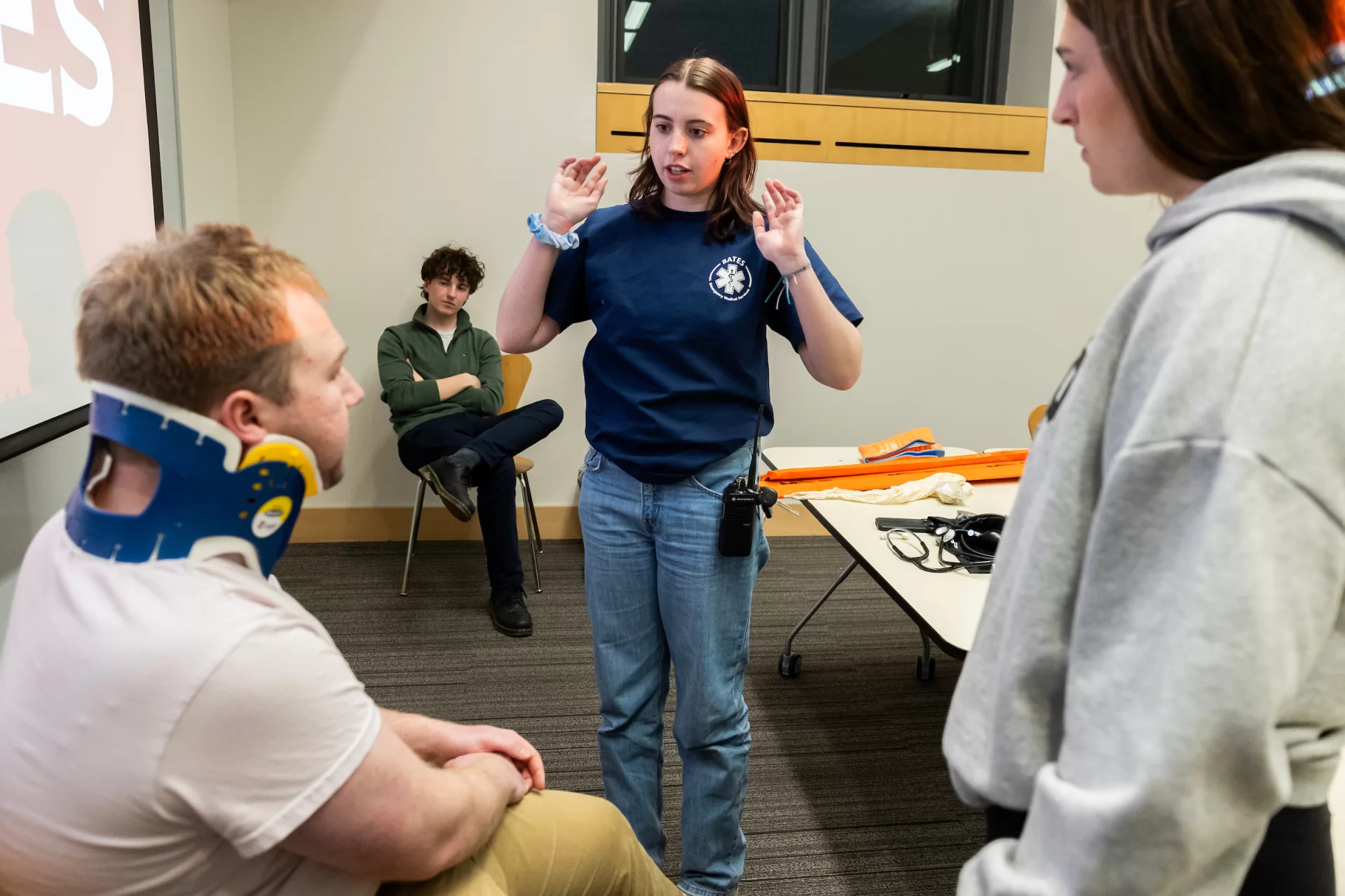
Dispatched through Campus Safety, most of the calls students respond to are minor health issues. But they have responded to car accidents on the roads around campus, helped administer bandages to stop bleeding, and cared for head injuries. In one instance, they provided CPR when a student had a seizure and stopped breathing.
Their response time to the roughly 120 calls they answer during the school year averages just three minutes. “That’s excellent,” says Paul Menice, director of Bates Campus Safety, and is the reason he can direct the campus community to call Campus Safety for a medical emergency. “You will get a quicker response calling Campus Safety than calling 911. Especially with BEMS, they have a quick response time.”
“For us, it’s been great having them as a partner. They’re showing up, and they’re doing it.” — Director of Bates Campus Safety Paul Menice
BEMS also works at campus events, from Puddle Jump to Commencement. On May 4, they assisted Campus Safety to provide support at President Garry W. Jenkins’ inauguration.
“They add another layer of (campus) safety and another first responder in an emergency situation,” says Menice, a 35-year member of the Bates staff who has observed BEMS since its infancy. “For us, it’s been great having them as a partner. They’re showing up, and they’re doing it.”
Once a month, the students train with Campus Safety in mock scenarios to stay sharp for an actual emergency. The co-chiefs meet regularly with Bates staff and David Russell at United Ambulance to plan training sessions, simulations, and events, like one held last February when BEMS partnered with Campus Safety to showcase the work done by Maine first responders. The event featured a LifeFlight of Maine helicopter landing on Bardwell Field.
“One of my greatest takeaways is the skill to be able to talk to people, any person, in their time of need.” — Jillian Sheltra ’19
About 70 percent of the BEMS students go on to work in a medical field, according to Student Affairs. The exposure to emergency medicine is top shelf. But many BEMS alums say the life skills they learned are applicable in ways beyond the walls of a hospital.
“In my career up to this point, one of my greatest takeaways is the skill to be able to talk to people, any person, in their time of need,” says Jillian Sheltra ’19 of Portland, Maine, a BEMS alumna who is a paramedic for LifeFlight, a nonprofit and Maine’s only air ambulance service. “Without that, I don’t think I would have ever developed personally. For that, I definitely credit BEMS.”
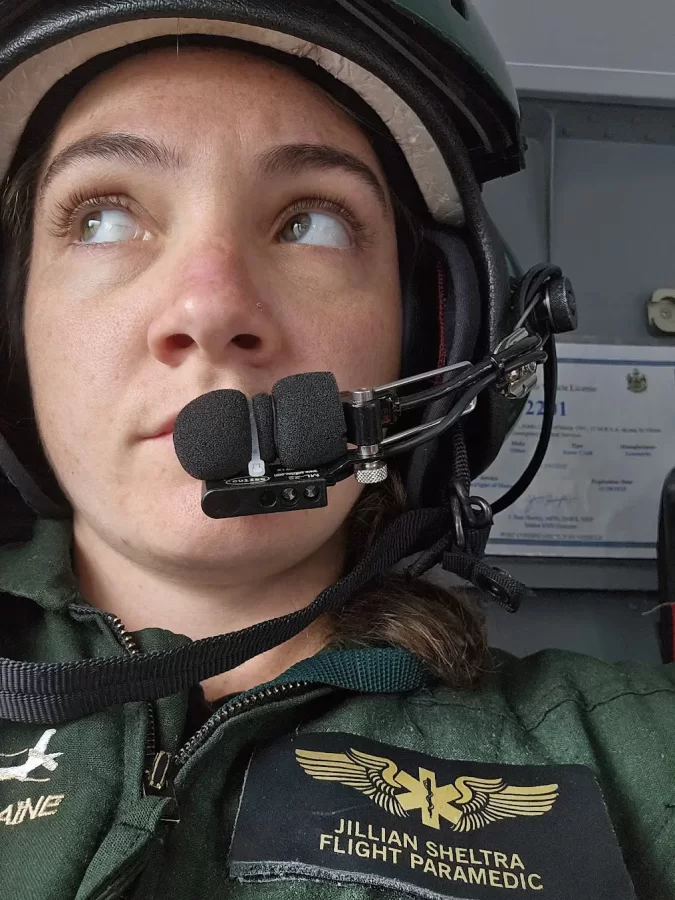
After she joined BEMS, Sheltra went on to work part time for United Ambulance, assisting veteran EMTs of 20 and 30 years. The medical care she witnessed those seasoned EMTs provide left an impression not just for its medical dimension, but in how it offered an intimate view of humanity seldom seen by modern medical practitioners.
“You go into people’s homes. That is an incredibly unique perspective. I absolutely loved that piece of it,” Sheltra says.
This fall, after caring for more than 350 LifeFlight patients and traveling more than 20,000 miles aboard LifeFlight helicopters, Sheltra has begun medical studies at Tufts School of Medicine.
Sophie Love-Webb ’24 of Lewiston, a former co-chief who worked part time for United, says working on the local ambulance was invaluable for getting her outside the “Bates bubble.”
“It made me feel a lot more balanced as a student at Bates. I felt like I had a community in Lewiston. I had friends in Lewiston. I felt like I understood the Lewiston community a lot better. I left campus often,” says Love-Webb, now a full-time EMT at United.
BEMS was a big reason Aleisha Martinez Sandoval ’26 chose to come to Bates. Sandoval moved away from her family in Mexico City at age 15 so that she could attend a Texas vocational school where she could serve on an ambulance and get her EMT certification. As a high school senior she already had the goal of pursuing a career in medicine as a physician.
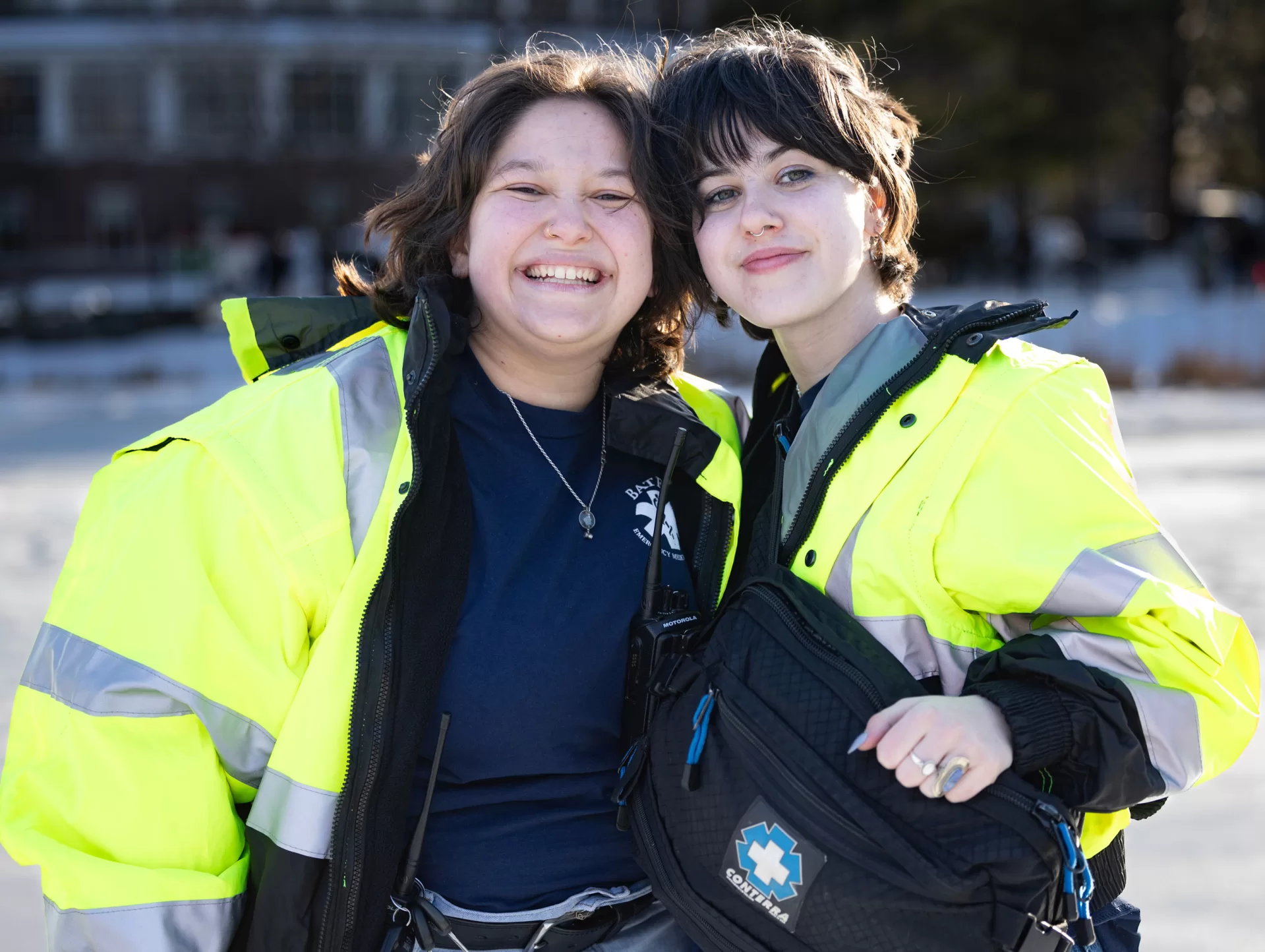
“I really like that it’s something that we have here. People feel that they can call us. Most of the people in the service genuinely care about what they do. It gives you a good connection with people who are passionate about something you like,” Sandoval says. “I’ve known that this is my thing for a long time.”
“The value that I see in BEMS is the educational component. You can apply that level of commitment and growth and learning to anything else you do in life.” — Ned Friedman ’24
Many BEMS students who went on to careers in medicine didn’t know when they came to Bates what their path would be. But the service effectively serves as a broad funnel helping to guide students toward different pursuits in medicine, health, and wellness.
“We all come from different majors: environment, politics, biology, pre-med,” says Ethan Baker ’24 of Jackson, N.H.
For Friedman, who majored in politics, EMT service has been a powerful source of finding purposeful work, including working as a part-time advanced EMT with United and at Durham Fire & Rescue. This spring, Friedman also job-shadowed Kingdon, the paramedic in Maui. He is now firefighter recruit with West Metro Fire Rescue in Lakewood, Colo.
BEMS has provided Friedman a path to gain practical skills, “the intricate world of emergency medicine, which teaches you, quite literally, how to save someone’s life.” He also values its transferable skills like leadership and how to commit to something you care about.
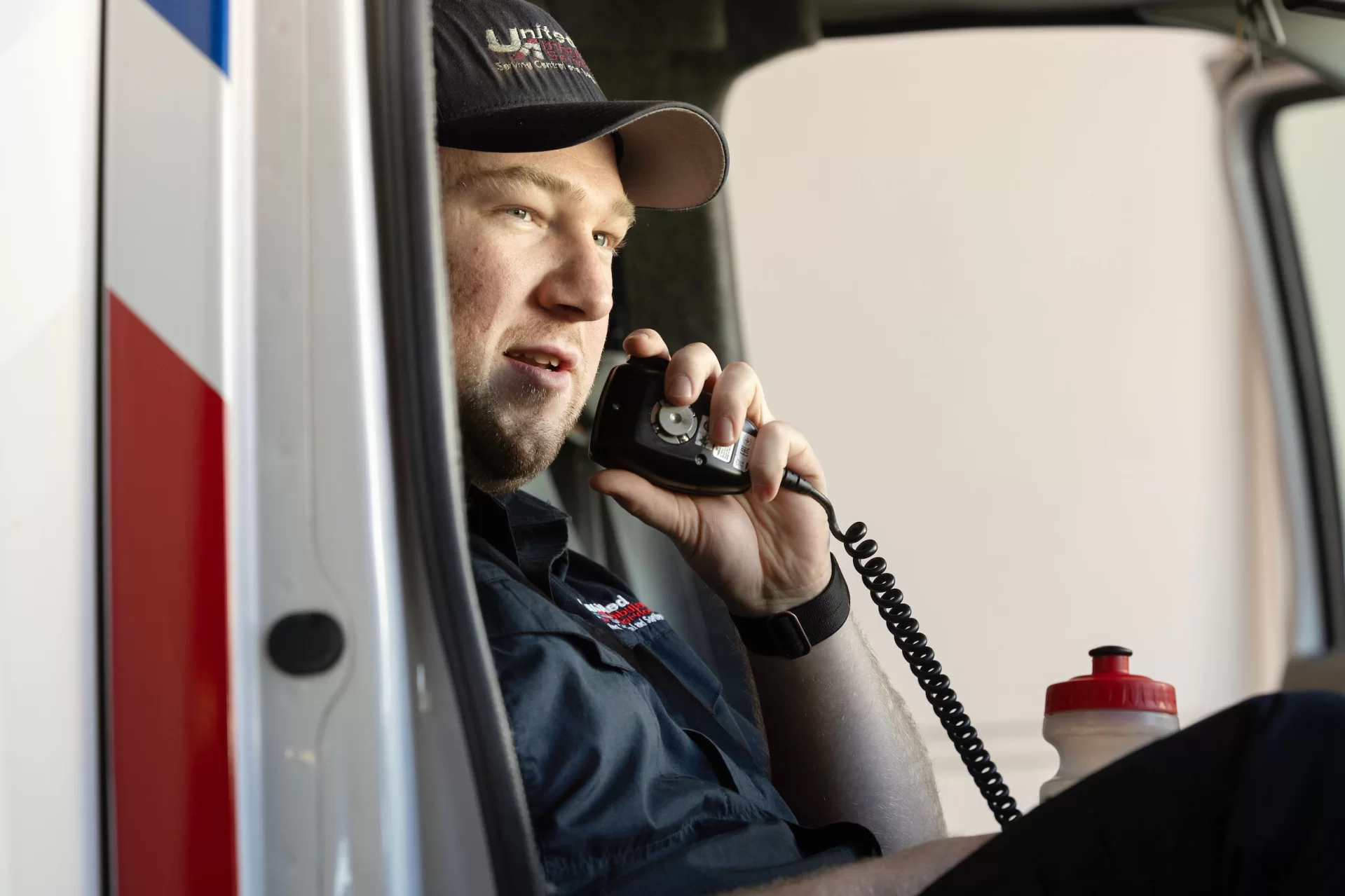
“The value that I see in BEMS is the educational component, putting in time and effort to learn and grow your skill set,” he says. “You can apply that level of commitment and growth and learning to anything else you do in life, even if you put your license aside after Bates.”
His co-chief Bachner agrees. “Even for someone who just drops into BEMS for a short time, it teaches great life lessons. It teaches you how to interact with people, how to stay calm, what you have in common with other people — just generally making yourself a useful human being.”
There are also BEMS veterans who pursue fields of work or study unrelated to public health and safety. The service helped them find their way, too.
After she graduated from Bates with a geology major in 2017, Madeline Bruno volunteered on a local ambulance crew during a two-year fellowship for the Island Institute, which helps support the public health and wellness and the sustainability of island communities along the Maine coast. Bruno says the experience of giving back to a community on Islesboro in that way was invaluable.
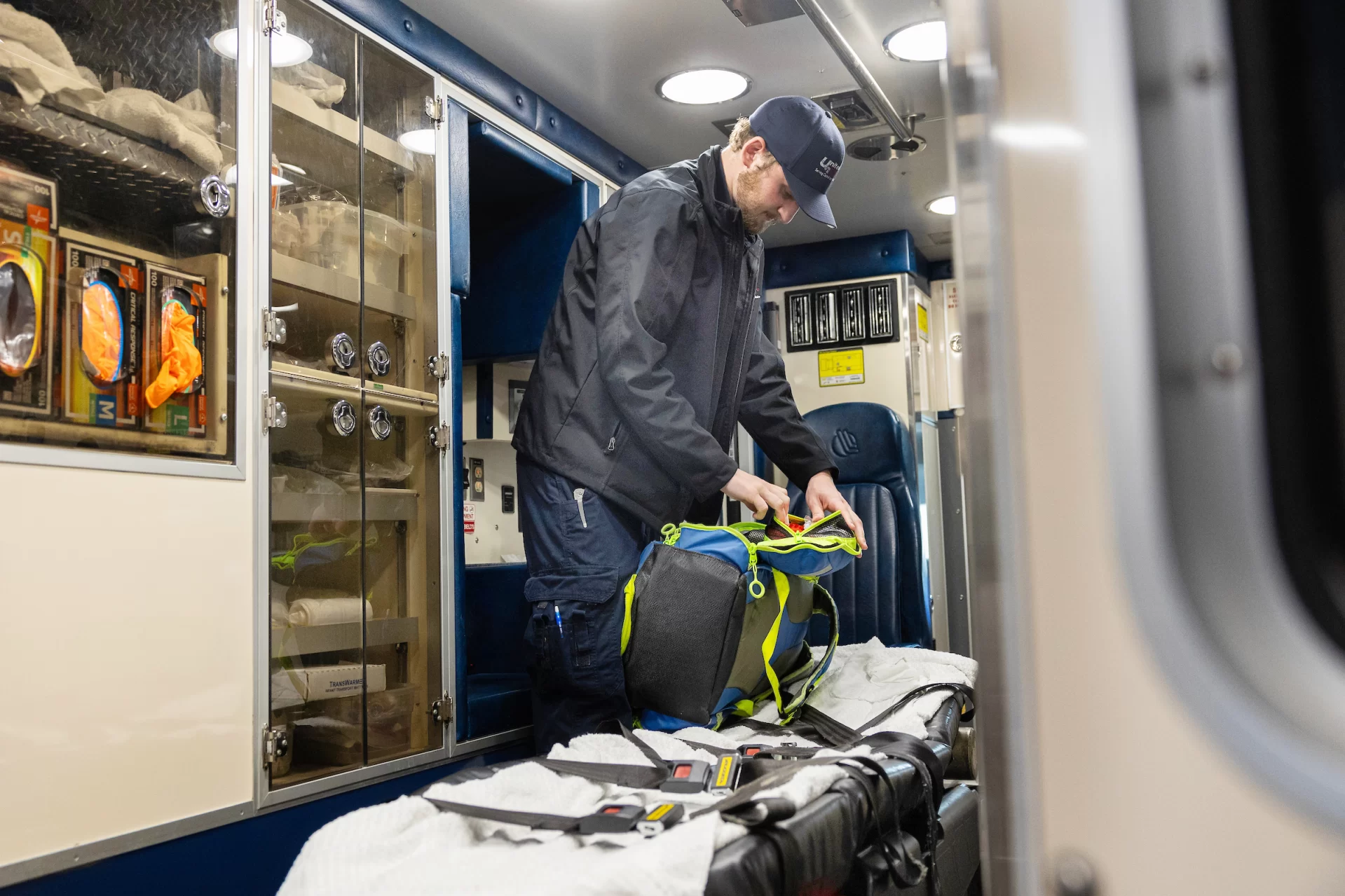
“I really got to know the community and, I think, some really vulnerable parts of the community,” she says.
Bruno lives in Augusta now and works for the engineering firm WSP in environmental remediation in remote parts of Maine, where commanding the skills of an EMT brings added value to her team.
“It’s really nice to have 38 subcontractors on a job site in a remote area and if something happens I can say: ‘Call 911, obviously, but call me, too. I can help,’” Bruno says.
Mike Schlechter, a BEMS co-founder and an EMT since age 16, initially planned to become a rabbi to serve his community in a meaningful way. He ended up going into management consulting with a focus on employee experience design and digital transformation — but never stopped being an EMT.
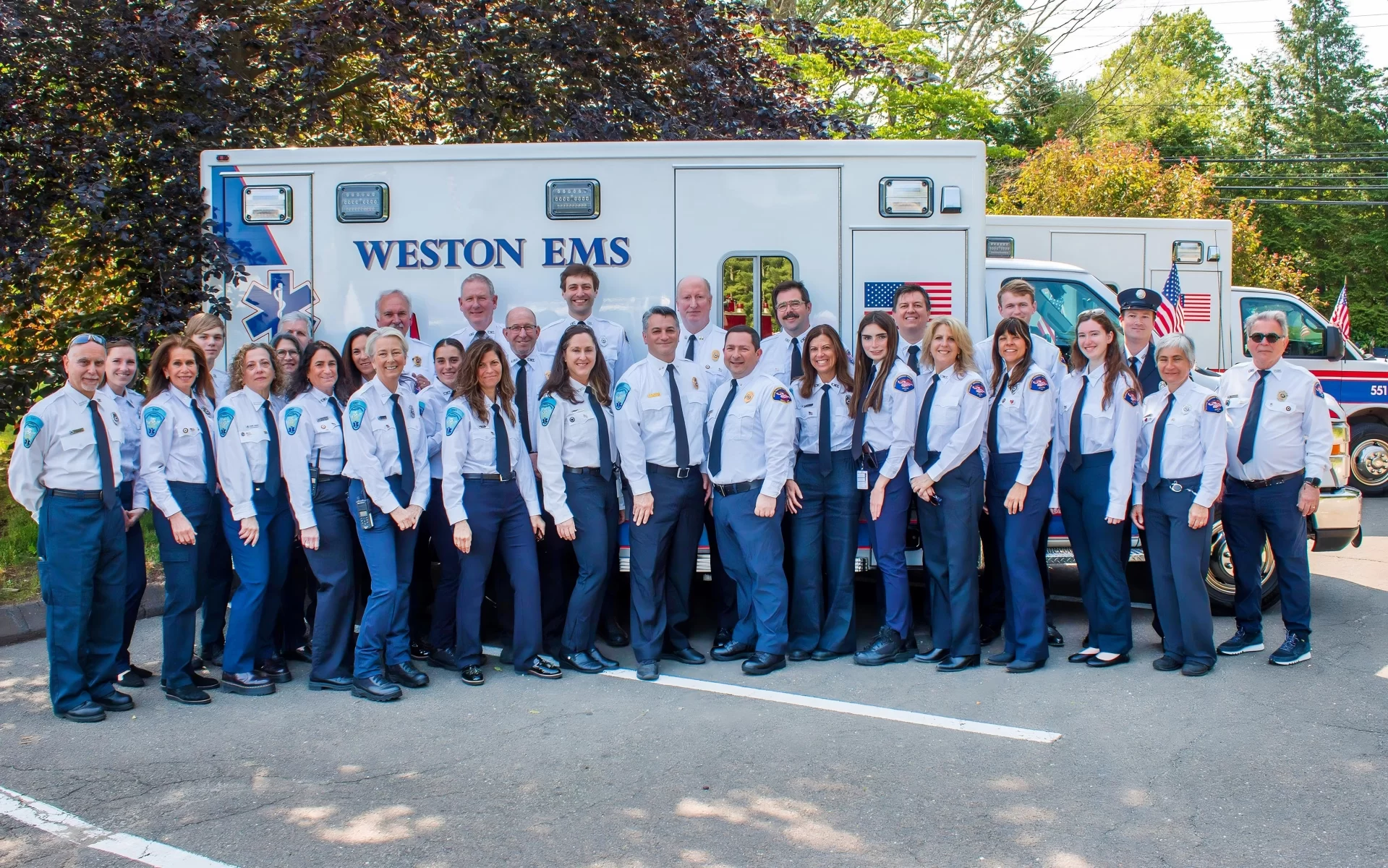
Today Schlechter is the volunteer chief of service of Weston (Conn.) Volunteer EMS, where he oversees a crew of 77 volunteer EMTs, one of whom is Noah Bachner, the current BEMS co-chief. “Being a rabbi ended up not being the path for me, for myriad reasons. Being a volunteer EMT was — and is,” Schlechter says. “For me, it’s always been about community service. That’s still true. Since I was a teenager, it’s been a big part of me and my identity.”
Fellow BEMS founder Pete Tilney wasn’t sure when he arrived at Bates if he wanted to go into medicine, or even if he was cut out for it. Helping to get BEMS off the ground and doing EMT work as a student proved to him he had what it took.
Some 25 years later, Tilney then proved how well-suited he was for the life of an emergency room physician. On the evening of Oct. 25, 2023, when a gunman brought unthinkable horror to Lewiston, Tilney got the news on his commute home to Kennebunkport, Maine.
He turned around and returned to Central Maine Medical Center, where he quarterbacked the LifeFlight response and the EMS crews that called from as far away as Boston to offer assistance in the triage effort.
Professionals like Tilney know that there’s no such thing as “it can’t happen here.”
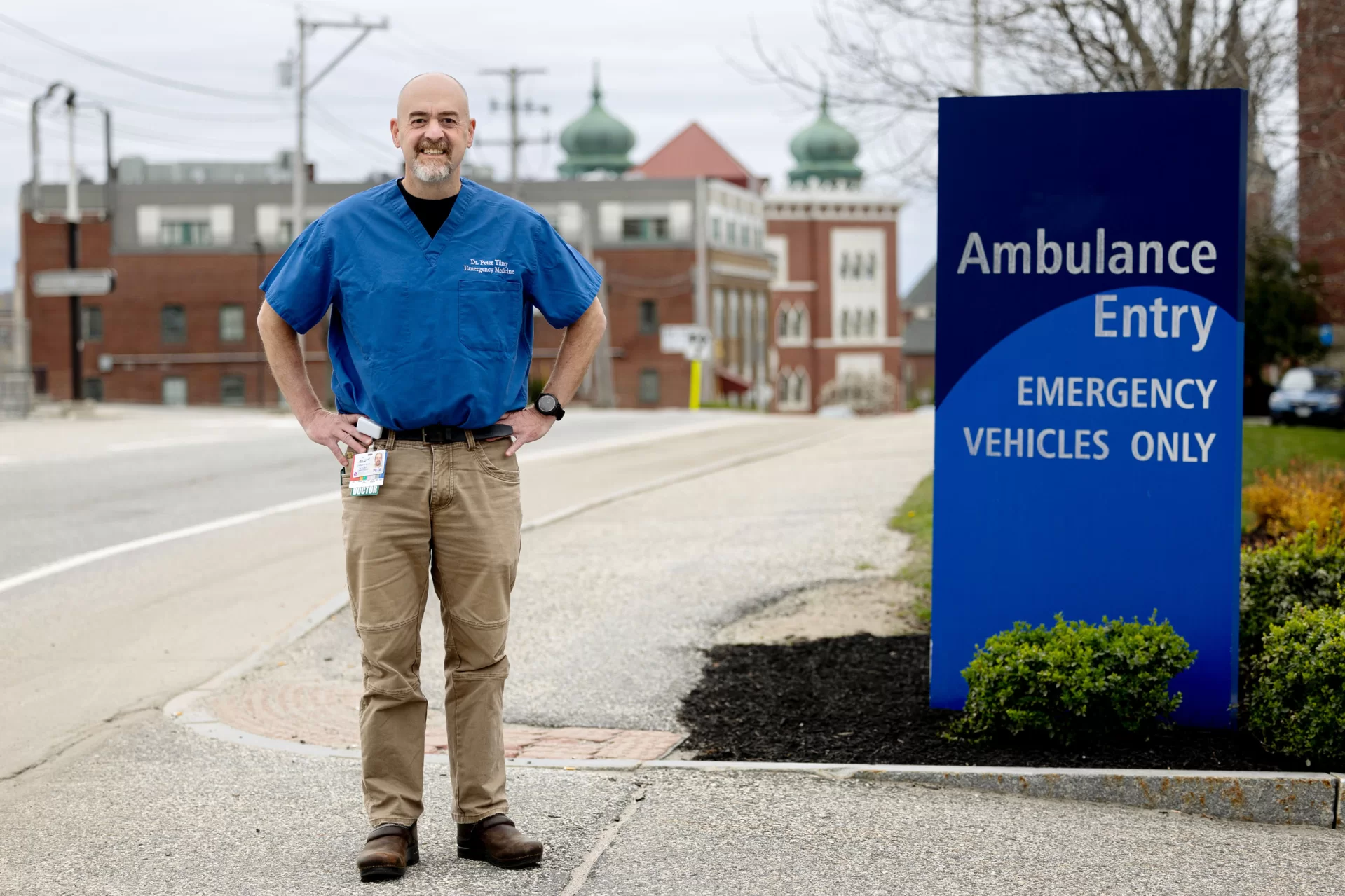
“Oct. 25 was awful, but it’s what we train for,” Tilney says. “The amazing thing is that people’s training and awareness really came together, and so we were able to take care of the community at large. We are sort of a big-small community. We are a really tight-knit community. So we were able to work cohesively, which was lovely.”
He added that the fact he works in Lewiston is directly related to the experience he had working for BEMS.
“BEMS gave me that foundation and appreciation for emergency medicine. I wouldn’t be doing this 25 years later if I hadn’t discovered at Bates that I really enjoy doing it,” he says. “And I wouldn’t still be working in Lewiston if I didn’t care about the community.”


